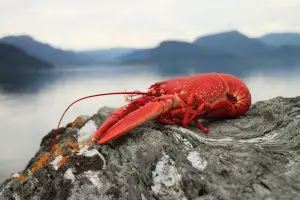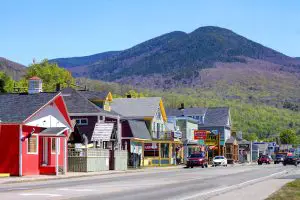As a lifelong resident of New Hampshire, I’ve made it my passion to learn more about what the state is known for. One collection of fun facts I’ve come across is the state’s symbols: purple lilac (state flower), ladybug (state insect) and red-spotted newt (state amphibian). As an avid birdwatcher, I wondered, what is New Hampshire’s state bird? I quickly learned it’s the purple finch. Keep reading to learn more about this feathered friend.
Historical Support for the Purple Finch
Let’s take a look at what happened before the purple finch officially became the New Hampshire state bird in 1957.
The bird’s history stems back to Representative Robert S. Monahan, a resident of Hanover and a Dartmouth College forester. Monahan was the one to sponsor the purple finch bill, which was put in front of the House of Representatives on February 12, 1957.
The colorful finch had a strong backing with support from the Audubon Society of New Hampshire, the State Federation of Women’s Clubs and the New Hampshire Federation of Garden Clubs. Let’s take a quick look at what these organizations are all about:
- Audubon Society of New Hampshire: A nonprofit organization focused on wildlife and habitat conservation throughout New Hampshire.
- State Federation of Women’s Clubs: An international organization with tens of thousands of members focused on promoting volunteer work and community service.
- New Hampshire Federation of Garden Clubs: An organization focused on promoting gardening, floral design, environmental responsibility and civic beautification across NH.
These prominent groups were all for the purple finch. However, one representative was not.
The Purple Finch vs. the New Hampshire Hen
The purple finch met some competition before it was made official. The opposer? Representative Doris M. Spollett. Spollett was a prize-winning goat breeder and veteran legislator who lived in Hampstead. Spollett wanted the “New Hampshire hen” to be the state bird. She had fought for it to be the official bird eight years earlier (in 1949) but her bill was unsuccessful.
The New Hampshire hen is gentle, docile and great for beginners looking to keep chickens. It’s known to grow fast, mature quickly and provide tasty eggs. The hen was bred from the Rhode Island Red and earned certification in 1935. The New Hampshire hen provided more meat and fewer eggs compared to the Rhode Island hen.
As an advocate for this backyard friend, Spollett was in strong opposition when the legislation came through for the purple finch.
The Purple Finch Becomes Official
The purple finch bill went before the House Committee on Recreation, Resources and Development on March 27, 1957. Monahan urged officials to act quickly because he worried another state would snag the bird as their state symbol.
With the hen up for debate, officials decided not to adopt it as their state bird. Two other states did have domestic fowl as their state birds. Delaware chose the Delaware Blue and Rhode Island chose the Rhode Island Red.
New Hampshire chose the beautiful purple finch. Governor Lane Dwinell made it official by signing the purple finch into law on April 25, 1957.
About the Purple Finch
So what’s the big deal with this purple finch? I did some research into them so you don’t have to.
Are They Actually Purple?
The purple finch’s scientific name is Haemorhous purpureus. Purpureus is Latin for “color of purple.” One of the first things to call out is that the purple finch isn’t actually purple.
Female purple finches are brown and white. The brown appears in streaks with bold streaks on their face. Male purple finches are unique with pink-red coloring on their back, head and breast. The red comes from eating carotenoids, so when food is scarce their color will be dull. Some scientists think females are attracted to brighter-colored male finches because it’s a sign that they’re well-fed and healthy.
Other Distinguishing Features of The Purple Finch
Purple finches are pretty small, measuring at about six inches tall. This is about the size of a sparrow but larger than small forest birds like chickadees or nuthatches.
The NH state bird is different from the sparrow with its conical beak. Just like it sounds, their beaks are shaped like a cone, which contributes to their large “chunky” look. They have a relatively short tail with a notched tip.
What Do Purple Finches Eat?
Purple finches are mostly vegetarians. They eat buds, seeds, fruit and berries. You can find them at bird feeders throughout New Hampshire, especially if they’re well-stocked with sunflower seeds.
Purple finches often forage high up in the trees where you can hear them but likely won’t see them. If you check out some hiking trails through the forests in New Hampshire, you might just spot some of these colorful feathered friends.
Where to Find Purple Finches
The purple finch can be found throughout Northern America (including New Hampshire of course). However, you won’t find them in northern Canada or in some areas in the western United States.
They mainly take up residence on the outskirts of forests (coniferous or coniferous-deciduous). However, purple finches can also hang out in orchards, pastures, shrublands, hedgerows and even backyards, especially during the winter.
Breeding and Lifespan of The New Hampshire State Bird
Purple finches breed between April and August. They have monogamous bonds and the males attract females by hopping around, puffing out their chest, and showing off their feathers.
Females will lay three to six speckled eggs and incubate them on their own while the males go off to get food. Once the baby birds hatch, they are dependent on their parents and eat regurgitated seeds. They’ll get their flight feathers after a couple of weeks but still rely on mom and dad to feed them for a few months. Once autumn hits, they’ll be mature and venture out into the New Hampshire wild on their own.
New Hampshire’s purple finch can live up to 14 years in the wild. However, they usually don’t live past a couple of years and often die after just a few months. This is due to predators, diseases and other risks. Purple finch predators include barn owls, grackles, hawks, blue jays, merlins, American kestrels, squirrels, cats and dogs.
Are Purple Finches Rare?
Partners in Flight, a conservation organization, estimated the purple finch population to be around 6.4 million, worldwide. The population has been declining, potentially due to the house finch. House finches are closely related and came to the eastern United States in the 1940s. Since then, purple finches have had to compete with house finches in overlapping territories.
Purple Finches in New Hampshire
States usually choose their state bird based on what’s popular there (that’s why so many states have the cardinal as their state bird). Lucky for the residents of NH, the adorable purple finch is pretty common.
Residents of New Hampshire can attract the not-so-purple finch to their bird feeders by filling them with black-oil sunflower seeds. If you have conifer trees in your yard, you’re even more likely to draw them in.
The New Hampshire purple finch is a unique and fun bird with its bold red coloring or creative brown streaking. With an interesting history of battling the New Hampshire hen for the position of NH state bird, the purple finch is a well-known symbol you’re sure to enjoy when you head out birdwatching.
PS – To learn more about New Hampshire click here.



